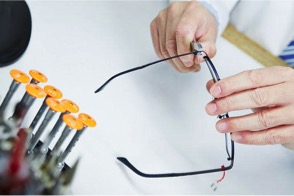
A few months ago, a customer came into my store and started explaining how unhappy she was with a pair of glasses we sold to her. She was on the verge of becoming a high myope and had over 2.25D astigmatism for each eye. She picked up the new glasses a day ago and compared to her old frames, the new frame was shaped differently. The initial complaint was about the look of the lenses in the frame and the idea the lenses were going to “fall out” because they stuck out on the edges. After about forty minutes of explaining and demonstrating, she still ended up returning the glasses. Countless questions and solutions kept hovering in my mind, but I realized the truth: you’re never going to be able to please everyone. The optician and I explained frame choice, thickness, lens materials and treatments, astigmatism, myopia, pretty much all the information and recommendations we could possibly relay about the prescription. This was one of those times when the patient has been wearing glasses all her life but was never informed about thickness and frame choice. She couldn’t understand why she was seeing differently in her new frame, a clear transparent and dramatic cat eyed shape, versus her old frame, which was a black and classic square/rectangular shape. Is it possible she went her WHOLE life without a doctor or optician going into depth about her prescription? It’s unlikely, but anything is possible. Regardless of the return or the fact that she was unhappy with the frame choice, I felt that I did my job educating the patient to the best of my ability so she can bring that knowledge wherever she wants to shop.
The location where I work is high-volume. We sell many pairs of glasses, however we also encounter our fair share of satisfied and dissatisfied customers. Troubleshooting issues for patients can still be a struggle, especially when we don’t have a history on file. I had no choice but to get comfortable with tackling problems on my own because we are so busy with customers. It’s uncommon that I would be the optician that the patient will encounter for the entire journey from choosing and purchasing the glasses, assembling/inspecting the pair, and dispensing the glasses to them. When someone has trouble seeing upon dispense, we must start all over by checking the prescription again, making sure the frame choice is acceptable, adjust the frames or sometimes adjust the measurements. Because I was new and nervous, the beginning was challenging. However, I had the advantage of working as a sales associate before I jumped into my apprenticeship which made the transition much easier. It was nerve-wracking to adjust frames, and I was constantly seeking my preceptor for assistance. I was timid and afraid to break a frame or misuse tools. It took about a month or two before I felt comfortable with adjustments and taking measurements. Being an apprentice optician for almost a year and handling my fair share of struggles allowed my skills to develop and prepare me for becoming an optician. Having those skills, I rarely seek assistance and usually figure it out on my own. Adjustments and repairs tend to be one of the fun aspects of the job and I like to take all the practice I can get. The majority of my daily challenges consists of RX issues, segment heights being incorrect (usually with multifocals) or wrong frame or lens choices.This is the type of job where consistency and repetition are immensely valuable to the patient. Repeating the same speech about myopia or progressives can get tedious, and it’s possible details are being left out. Studying optics makes me aware of what a -7.00 diopter lens looks like in various materials but I can’t assume the patient has been educated as much as I have. Regardless whether they have a history of wearing glasses, I always describe and demonstrate all their options so they know exactly what they are paying for. It’s not difficult to convince someone about the value they are getting when they buy the glasses because they can physically see with their new glasses. But I noticed when it comes to discussing routine eye exams, patients are quick to say, “I see fine,” and refuse to have their eyes checked. This continues to be a struggle because I love persuading people to better themselves, although this can be a sensitive subject for some folks who don’t have insurance or had awful experiences. I’m a very honest person and that usually helps in demonstrating the reality that we use our eyes for everything. Why wouldn’t anyone want to see as clearly as possible and know for sure they have healthy eyes? Despite the innumerable issues I encounter, I still manage to learn from them, work through the difficult situations and be as informative as I can be. I do my best and always share my knowledge to help someone. That’s fulfilling after a long day of work. Learn why your expertise, in every aspect of the purchase decision, is an invaluable feature with our CE, The Journey from Expert Technician to Creative Artisan at 2020mag.com/ce.












